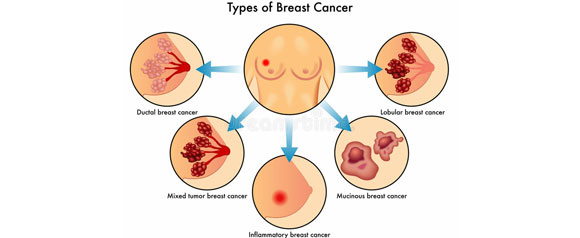Breast Cancer Treatment

Breast cancer is the most commonly occurring cancer among women. A breast lump that is malignant is referred to as breast cancer.
A breast lump or thickened tissue in the breast
Pain in the armpits
Breast whose shape or size doesn’t change with monthly cycle
Dimpling or redness of skin of breast
Rashes on or around nipples
Unusual discharge from nipples which is milky, yellow or red(blood).
Sunken or inverted nipple
Irregular shaped breast
Peeling or scaling of skin on the breast
Age – With increasing age, chances of breast cancer also increases
Genetics – Women with a genetic predisposition of breast cancer have a higher risk of developing one. Women with BRCA1 and BRCA2 genes have a higher risk of developing breast cancer, ovarian cancer or both. These genes can be inherited.
History of breast cancer or lumps – Women who already have developed breast cancer or benign lumps earlier in their life are likely to get it again
Dense breast tissue
High estrogen levels in the body due to early onset of menstrual cycle or late menopause
Obesity
High alcohol consumption
Radiation exposure – When undergoing radiation to treat any other cancer in the body, chances of breast cancer increases
Hormone therapy – Hormone replacement therapy or over usage of oral birth control pills increases estrogen levels in the body
Occupational hazards causing hormonal disturbance or developing carcinogens in the body
Self breast examination – Identify any irregularities, lumps, discharge or other symptoms
Mammogram to do initial screening of breast irregularities or tumors
Ultrasound to identify solid mass or fluid filled cysts
MRI to check spread of cancer
Biopsy to confirm and identify type of malignancy in the cells – size of tumor, invasive/non-invasive, spread, metastasis to determine staging
Ductal Carcinoma: Tumor develops in the milk ducts of the breast
Lobular Carcinoma: Tumor develops in the lobules in the breast
Breast cancer be non invasive initially where it is developed within the site. Later it may invade into other parts of the breast and become invasive.
Based on size of the tumor, its spread to lymph nodes and other organs, stages of breast cancer are identified.
Stage 0: Ductal carcinoma in situ (DCIS) where tumor has developed in the ducts and not invaded anywhere else
Stage 1: Tumor is upto 2 cm in size and not affected any lymph nodes
Stage 2: Tumor is above 2 cm and had invaded in nearby nodes
Stage 3: Tumor is upto 5 cm and has affected some lymph nodes
Stage 4: Tumor has metastasized, ie, spread to other organs
Treatment of Breast Cancer Treatment
Based on size of the tumor, its spread to lymph nodes and other organs, stages of breast cancer are identified.
Surgery
Radiation therapy
Chemotherapy
Hormone therapy
Targeted drug therapy







